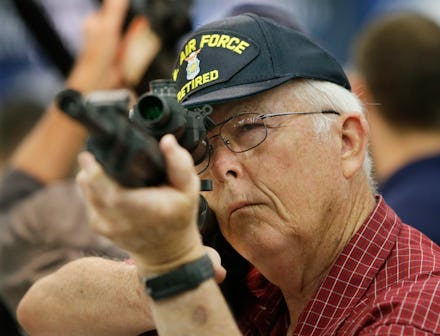When Black Men Are Shot and Killed, the NRA Is Silent

When a gunman shot and killed 26 students and staff inside Sandy Hook Elementary School in 2012, leaders of the National Rifle Association called for armed security guards in U.S. schools.
But what does the NRA do when a black man carrying a concealed permit is shot by police? Not a damn thing.
On Wednesday night, Philando Castile was shot and killed by police during a traffic stop in Falcon Heights, Minnesota. In a press conference Thursday morning, Castile's girlfriend, Diamond Reynolds, said Castile was permitted to conceal and carry a firearm. She also said he wasn't reaching for his gun. He was following police instructions to show his ID.
So far, in the wake of Castile's death, the NRA has been silent about the importance of the second amendment. That's not unusual. While the NRA advocates passionately for Americans' right to own guns, it has historically — and hypocritically — remained silent when black men, armed and unarmed, are killed by police.
Alton Sterling
The day before Philando Castile was shot and killed, 37-year-old Sterling was shot and killed by police in Baton Rouge, Louisiana.
The NRA made no statement about either shooting. But today — as the country still reels from Sterling and Castile's deaths — what's the NRA going on about? A #ThrowbackThursday retweet of confederate rifles.
Michael Brown
On August 9, 2014, Michael Brown, an 18-year-old unarmed black man, was shot and killed by police officer Darren Wilson. When protests formed in Ferguson, Missouri — and citizens were confronted by the sort of military showing better fit for overthrowing a dictator than keeping the peace — the NRA was nowhere to be found.
Instead, NRA board member Ted Nugent went on a tirade blaming Brown for his own death.
Tamir Rice
In November 2014, a Cleveland police officer shot and killed 12-year-old Tamir Rice when he was in possession of a pellet gun. The police officer's defense was that he thought Rice was a 20-year-old man in possession of a lethal weapon.
That argument didn't exactly hold up. Cleveland has open-carry laws. So even if Rice were 20 and had an actual firearm on his person, he shouldn't have been in trouble. As a Dallas Morning News column pointed out at the time, open-carry advocates were silent after Rice's death. That includes the NRA, which typically advocates for open-carry laws.
Trayvon Martin
On February 26, 2012, neighborhood watchman George Zimmerman shot 17-year-old Trayvon Martin for little more than perceiving the boy as "a suspicious person." Though Trayvon Martin's death wasn't a police shooting, the NRA remained silent there, too.
When the NRA responded to news of the murder, it wasn't to suggest Martin would have been safer if he'd had a gun. It was to condemn media outlets for sensationalizing reports.
The theme is clear: While the NRA implied arming students and teachers after the Sandy Hook Elementary School shooting, it's nowhere to be found when the guns are aimed at unarmed black men. And the country knows it.
Read more: